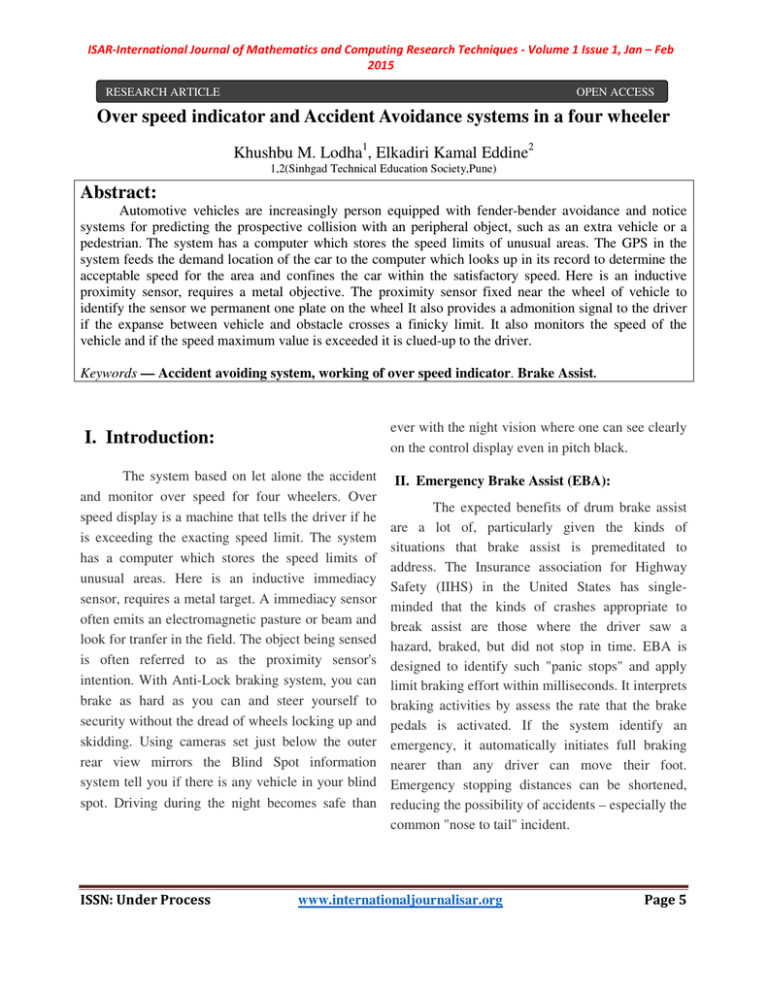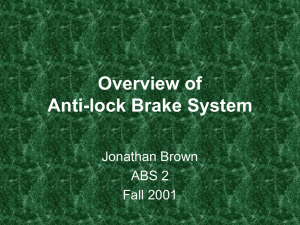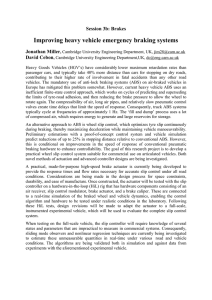Over speed indicator and Accident Avoidance systems in a four
advertisement

ISAR-International Journal of Mathematics and Computing Research Techniques - Volume 1 Issue 1, Jan – Feb 2015 RESEARCH ARTICLE OPEN ACCESS Over speed indicator and Accident Avoidance systems in a four wheeler Khushbu M. Lodha1, Elkadiri Kamal Eddine2 1,2(Sinhgad Technical Education Society,Pune) Abstract: Automotive vehicles are increasingly person equipped with fender-bender avoidance and notice systems for predicting the prospective collision with an peripheral object, such as an extra vehicle or a pedestrian. The system has a computer which stores the speed limits of unusual areas. The GPS in the system feeds the demand location of the car to the computer which looks up in its record to determine the acceptable speed for the area and confines the car within the satisfactory speed. Here is an inductive proximity sensor, requires a metal objective. The proximity sensor fixed near the wheel of vehicle to identify the sensor we permanent one plate on the wheel It also provides a admonition signal to the driver if the expanse between vehicle and obstacle crosses a finicky limit. It also monitors the speed of the vehicle and if the speed maximum value is exceeded it is clued-up to the driver. Keywords — Accident avoiding system, working of over speed indicator. Brake Assist. ever with the night vision where one can see clearly on the control display even in pitch black. I. Introduction: The system based on let alone the accident and monitor over speed for four wheelers. Over speed display is a machine that tells the driver if he is exceeding the exacting speed limit. The system has a computer which stores the speed limits of unusual areas. Here is an inductive immediacy sensor, requires a metal target. A immediacy sensor often emits an electromagnetic pasture or beam and look for tranfer in the field. The object being sensed is often referred to as the proximity sensor's intention. With Anti-Lock braking system, you can brake as hard as you can and steer yourself to security without the dread of wheels locking up and skidding. Using cameras set just below the outer rear view mirrors the Blind Spot information system tell you if there is any vehicle in your blind spot. Driving during the night becomes safe than ISSN: Under Process II. Emergency Brake Assist (EBA): The expected benefits of drum brake assist are a lot of, particularly given the kinds of situations that brake assist is premeditated to address. The Insurance association for Highway Safety (IIHS) in the United States has singleminded that the kinds of crashes appropriate to break assist are those where the driver saw a hazard, braked, but did not stop in time. EBA is designed to identify such "panic stops" and apply limit braking effort within milliseconds. It interprets braking activities by assess the rate that the brake pedals is activated. If the system identify an emergency, it automatically initiates full braking nearer than any driver can move their foot. Emergency stopping distances can be shortened, reducing the possibility of accidents – especially the common "nose to tail" incident. www.internationaljournalisar.org Page 5 ISAR-International Journal of Mathematics and Computing Research Techniques - Volume 1 Issue 1, Jan – Feb 2015 while driving can, amongst other possessions, impair the driver's ability to steer the car. Corner Traction Control - (CTC) CTC compensates for under steer and allows higher than normal rushing in a bend without wheel spin on the inner wheel, e.g. on an arcing motorway entrance road to quickly reach the prevailing traffic speed. Trailer Stability Assist Trailer stability assist function is to stabilize the car and trailer combination if it begins to snake. For more information, see Driving with a trailer. Fig.1 Emergency Brake Assist (EBA) III. Dynamic Stability and traction Control (DSTC): This task is designed to help condense wheel spin by transferring power from a drive wheel that begins to lose toehold to the wheel on the reverse side of the vehicle (on the same axle). TC monitors and compares the rotational speed of the drive wheels. If one of the drive wheels shows a affinity to spin, the difference in speed is immediately detected. Active Yaw Control: The task checks the driving and brake energy of the wheels individually in order to calm the car. Spin Control The task prevents the driving wheels from turning against the road surface during acceleration. Traction control system The function is dynamic at low speed and transfers power from the driving wheel that is turning to the one that is not. Traction control system The function is active at low speed and transfers power from the driving wheel that is turning to the one that is not. Engine drags control - (EDC) EDC (Engine Drag Control) prevents automatic wheel locking, e.g. after shifting down or locomotive braking when driving in low gears on smooth road surfaces. Involuntary wheel locking ISSN: Under Process Fig2. Dynamic Stability and traction Control IV. Electronic Brake Distribution (EBD) As per the technical paper published by Buchman et al. "The job of the EBD as a subsystem of the ABS structure is to control the valuable adhesion utilization by the rear wheels. The pressure of the care for wheels are approximated to the ideal brake force delivery in a partial braking operation. To do so, the usual brake design is custom-made in the path of rear pin over braking, and the machinery of the ABS are used. EBD reduces the strain on the hydraulic brake energy proportioning valve in the vehicle. EBD optimizes the brake design with regard to: adhesion utilization; driving permanence; wear; temperature stress; and pedal energy."EBD may work in combination with ABS[5] and Electronic Stability Control ("iESC") to decrease yaw accelerations during turns. ESC compares the steering wheel angle to vehicle www.internationaljournalisar.org Page 6 ISAR-International Journal of Mathematics and Computing Research Techniques - Volume 1 Issue 1, Jan – Feb 2015 turning rate using a yaw rate sensor. he sensors are so sensitive, and the actuation is so quick that the system may correct direction before the driver reacts. ABS helps put a stop to wheel lock-up and EBD helps apply appropriate brake force to make ESC work effectively and easily. skidding and allows you to keep up steering control. Fig3. Electronic Brake Distribution V. Anti-Lock braking system (ABS) Stopping a car in a urgency on a slippery road can be very difficult. Anti-lock braking systems (ABS) take a lot of the face up to out of this sometimes nerve-wracking incident. In fact, on slippery surfaces, even professional drivers can't stop as speedily without ABS as an average driver can with ABS.In this article, the last in a six-part series on brakes, we'll find out all about anti-lock braking systems -- why you want them, what's in them, how they work, some of the general types and some associated problems. Control under heavy braking Fig6. Anti-Lock braking system (ABS) ABS allows you to maintain control of the vehicle. Since four-wheel ABS prevents all wheels from VI. Conclusion: skidding, it allows you to steer the vehicle and still maintain braking. A speed feeler is used to resolve the acceleration or How does it work? deceleration of the wheel. These sensors use a pull and a coil of wire to create a signal. The rotation of ABS uses wheel speed sensors to establish if one the wheel or degree of difference induces a or more wheels are demanding to lock up during magnetic field more or less the sensor. The braking. If a wheel tries to lock up, a series of fluctuations of this magnetic field generate a hydraulic valves maximum value or condense voltage in the sensor. Since the power induced in the braking on that wheel. This prevents ISSN: Under Process www.internationaljournalisar.org Page 7 ISAR-International Journal of Mathematics and Computing Research Techniques - Volume 1 Issue 1, Jan – Feb 2015 the sensor is a result of the revolving wheel, this sensor can become inaccurate at slow speeds. The slower going round of the wheel can cause inaccurate fluctuations in the magnetic field and thus cause inaccurate readings to the controller. Reference: [1] S.P. Bhumkar, V.V. Deotare, R.V.Babar ”accident avoidance and detection on highways”- International Journal of Engineering Trends and Technology- Volume3Issue2- 2012 [2]Heng K W J, Lee A H P, Zhu S, Tham K Y, ―Helmet use and bicyclerelated trauma in patients presenting to an acute hospital in Singaporeǁ, Singapore Med J 2006, PP 367-372 [3] Alex Tay, Javier Ibanez Guzman, ―A Global Path Planning System using Local Navigation Strategiesǁ, Proceedings of the 32nd International Symposium on Robotics, April 2001,PP 329-336. [4]Honglie Leng,Yingzi Lin, ―Design & Experimental study of CNT sensor for measuring alcohol content with short response delayǁ IEEE Sensor Journal, 2010, PP 1091-1097 [5] Samer Ammoun, Fawzi Nashashibi, Claude Laurgeau "Realtime crashavoidance system on crossroads based on 802.11 devices and GPSreceivers", in proceedings of the IEEE ITSC 2006, IEEE IntelligentTransportation Systems Conference Toronto, Canada, September 2006. [6] A. Wheeler, “Commercial Applications of Wireless Sensor Networksusing ZigBee”, IEEE Communications Magazine, April 2013. ISSN: Under Process www.internationaljournalisar.org Page 8




